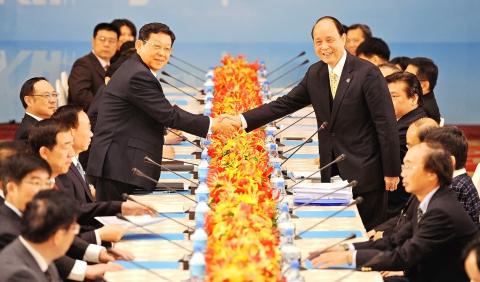Taiwan and China yesterday signed two cross-strait agreements on meteorological exchanges and earthquake monitoring, the 20th and 21st bilateral agreements inked since 2008, during the 10th round of cross-strait talks in Taipei.
Under the agreements, Taiwan’s Straits Exchange Foundation (SEF) and China’s Association for Relations Across the Taiwan Straits (ARATS) will organize task forces and establish communication channels on weather prediction and forecast, earthquake warnings and technological cooperation in meteorology, and seismic information.
SEF Chairman Lin Join-sane (林中森) said the pacts would allow the two sides to join efforts to better protect people from natural disasters amid severe weather conditions around the world.

Photo: Liu Hsin-de, Taipei Times
Taiwan and China began information exchanges and cooperation in 1982. Following the signing of the pacts, the Central Weather Bureau (CWB) of Taiwan will work with China’s Meteorological Administration and Earthquake Administration to improve the accuracy of weather forecasts and the prevention of natural disasters across the Taiwan Strait, he said.
Security authorities on the two sides have also conducted national security reviews on the content of the agreements and ensured that the scope of information sharing and exchanges will not affect national security, he said.
CWB Director-General Shin Tzay-chyn (辛在勤) said the agreements would help better predict the arrival of dust storms in Taiwan, as pollutants blowing across the Taiwan Strait from China have increasingly affected the nation’s air quality.
The agreements were signed at the Grand Hotel in the afternoon after a top-official talk held between Lin and ARATS Chairman Chen Deming (陳德銘), during which the two exchanged landscape paintings and tapestries as a gesture to promote prosperity across the Taiwan Strait.
The next round of cross-strait talks will address issues including the trade of goods, dispute-resolving mechanisms, tax agreements, the establishment of representative offices on the two sides of the Taiwan Strait, environmental protection and flight safety standard cooperation.
When asked about the failure to sign a cross-strait tax agreement during this round of negotiations, Lin said there were still concerns about the content of the agreement, and the pact should be signed during the next round of cross-strait talks.
“The negotiation on the cross-strait tax agreement is almost done, but there are still some concerns, and we want to sign the agreement after we have more communication with the public and clear their doubts,” he said.
Other issues mentioned during the talks included the increase of cross-strait air routes and transit stops in Taiwan for Chinese citizens heading elsewhere.
Chang said the foundation and ARATS continued to negotiate the two issues, and the SEF also stressed that the cross-strait median would not be on the agenda in the negotiation of the transit stops in Taiwan.
“The cross-strait median involves national security and national defense, and there is no room for negotiation on the issue,” he said.

US President Donald Trump yesterday announced sweeping "reciprocal tariffs" on US trading partners, including a 32 percent tax on goods from Taiwan that is set to take effect on Wednesday. At a Rose Garden event, Trump declared a 10 percent baseline tax on imports from all countries, with the White House saying it would take effect on Saturday. Countries with larger trade surpluses with the US would face higher duties beginning on Wednesday, including Taiwan (32 percent), China (34 percent), Japan (24 percent), South Korea (25 percent), Vietnam (46 percent) and Thailand (36 percent). Canada and Mexico, the two largest US trading

AIR SUPPORT: The Ministry of National Defense thanked the US for the delivery, adding that it was an indicator of the White House’s commitment to the Taiwan Relations Act Deputy Minister of National Defense Po Horng-huei (柏鴻輝) and Representative to the US Alexander Yui on Friday attended a delivery ceremony for the first of Taiwan’s long-awaited 66 F-16C/D Block 70 jets at a Lockheed Martin Corp factory in Greenville, South Carolina. “We are so proud to be the global home of the F-16 and to support Taiwan’s air defense capabilities,” US Representative William Timmons wrote on X, alongside a photograph of Taiwanese and US officials at the event. The F-16C/D Block 70 jets Taiwan ordered have the same capabilities as aircraft that had been upgraded to F-16Vs. The batch of Lockheed Martin

GRIDLOCK: The National Fire Agency’s Special Search and Rescue team is on standby to travel to the countries to help out with the rescue effort A powerful earthquake rocked Myanmar and neighboring Thailand yesterday, killing at least three people in Bangkok and burying dozens when a high-rise building under construction collapsed. Footage shared on social media from Myanmar’s second-largest city showed widespread destruction, raising fears that many were trapped under the rubble or killed. The magnitude 7.7 earthquake, with an epicenter near Mandalay in Myanmar, struck at midday and was followed by a strong magnitude 6.4 aftershock. The extent of death, injury and destruction — especially in Myanmar, which is embroiled in a civil war and where information is tightly controlled at the best of times —

China's military today said it began joint army, navy and rocket force exercises around Taiwan to "serve as a stern warning and powerful deterrent against Taiwanese independence," calling President William Lai (賴清德) a "parasite." The exercises come after Lai called Beijing a "foreign hostile force" last month. More than 10 Chinese military ships approached close to Taiwan's 24 nautical mile (44.4km) contiguous zone this morning and Taiwan sent its own warships to respond, two senior Taiwanese officials said. Taiwan has not yet detected any live fire by the Chinese military so far, one of the officials said. The drills took place after US Secretary